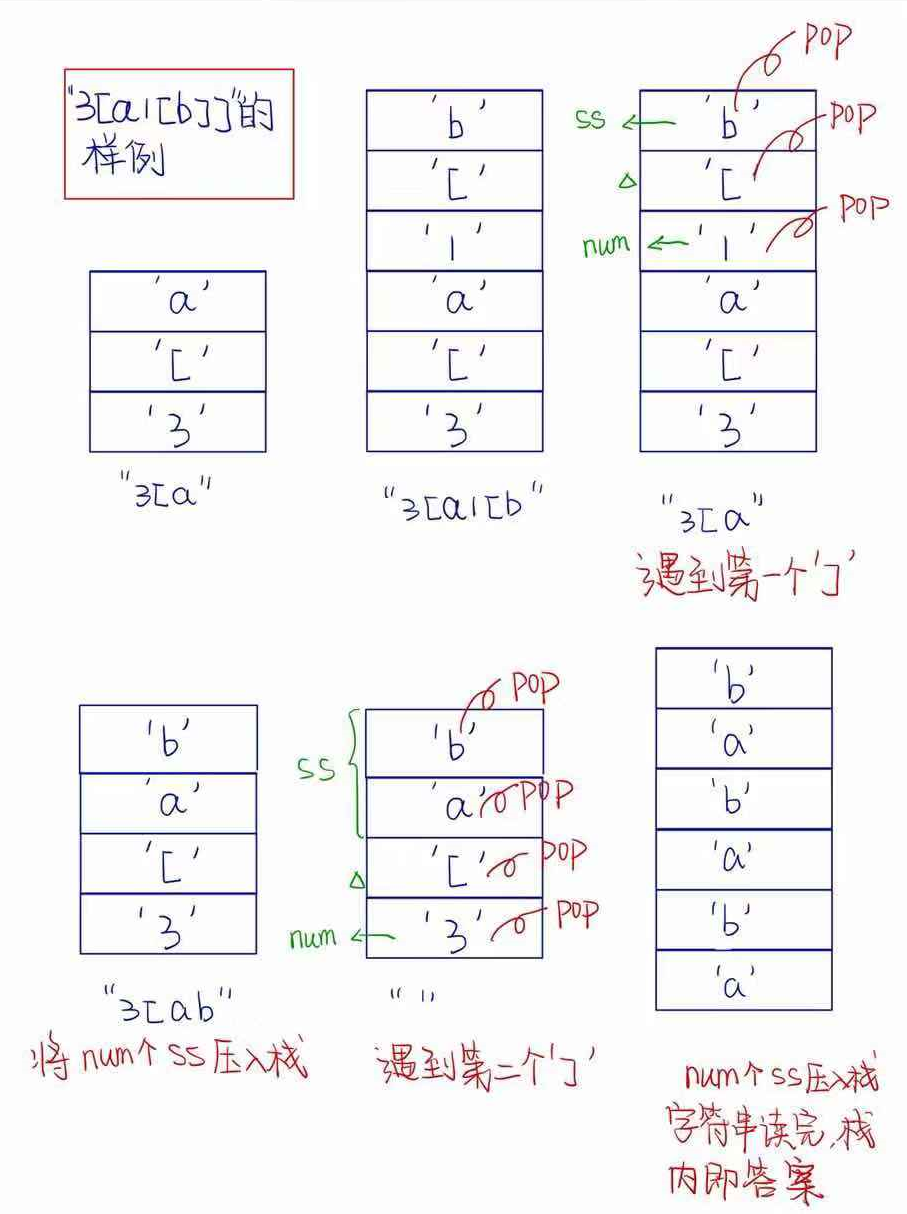[Leetcode]394.字符串解碼
題目與解釋
給定一個通過編碼的字符串,返回它解碼後的字符串。優化
編碼規則爲: k[encoded_string],表示其中方括號內部的 encoded_string 正好重複 k 次。注意 k 保證爲正整數。this
你能夠認爲輸入字符串老是有效的;輸入字符串中沒有額外的空格,且輸入的方括號老是符合格式要求的。編碼
此外,你能夠認爲原始數據不包含數字,全部的數字只表示重複的次數 k ,例如不會出現像 3a 或 2[4] 的輸入。code
示例:blog
s = "3[a ]2[bc]", 返回 "aaabcbc". s = "3[a2[c]]", 返回 "accaccacc". s = "2[abc]3[cd]ef", 返回 "abcabccdcdcdef".
解釋:遞歸
這道其實是一道字符串與棧結合的問題。如何看出是棧結合的問題呢?字符串
- 有匹配('['和']')的狀況,須要使用棧來完成匹配過程
- 有遞歸的狀況, 如3[2[ab]]這樣
在匹配符號上,我參照我以前寫的小型計算器的符號匹配,遇到']'就去尋找最近出現的匹配符號'['。string
思路
創建一個字符棧,這裏用的是STL自帶的stack<char>it
逐個讀入字符壓入棧,當遇到']'符號就尋找最近的匹配符號。io
這個尋找的過程就是不斷判斷棧頂是否爲'['符號?
->否。這個是括號內的字符,暫時存入一個字符串ss
->是。則尋找到匹配的字符,繼續往前尋找'['的字符前的全部"數字字符串",如34[22[ss]],那麼22就是[ss]的數字字符串,34則是[22[ss]]的數字字符串。在尋找完後須要將這個字符串轉換成實際的數字。
通過一次上述過程後,已經知道一個括號內字符串和這段字符串出現的次數k。咱們把k個字符串壓入咱們建立的字符棧。
而當全部字符都讀完了,則轉換實際上就已經結束了。咱們先根據思路寫一段解法,但效率還不是很高。
咱們看看"3[a1[b]]"的圖例

class Solution {
public:
string decodeString(string s) {
string ans = "";
stack<char>st;
/*visit all the character in the string s*/
for (unsigned i = 0; i < s.length(); i++) {
if (s[i] != ']')st.push(s[i]);
else {
/*
if we find the character ']', it means we find a pair.
string ss means the string in the pair of this times.
string num means the number k in the pair of this times.
Initialize these two strings as an empty string.
*/
string ss = "", num = "";
while (st.top() != '[') {
ss += st.top();
st.pop();
}
/*Delete '[' character*/
st.pop();
/*reverse the string ss*/
reverse(ss.begin(), ss.end());
while (!st.empty() && st.top() <= '9'&&st.top() >= '0') {
num += st.top();
st.pop();
}
unsigned times = 0, index = 1;
for (unsigned i = 0; i < num.length(); i++, index =index* 10) {
times += index * (num[i]-'0');
}
string sss ="";
for (unsigned i = 0; i < times; i++) {
sss += ss;
}
for (unsigned i = 0; i < sss.length(); i++) {
st.push(sss[i]);
}
}
}
/* push the k times string to the stack st*/
while (!st.empty()) {
ans += st.top();
st.pop();
}
reverse(ans.begin(), ans.end());
return ans;
}
};
很暴力的按照思路的過程寫了代碼,優化點是能夠本身寫一個stack而不是使用STL的stack,使這個本身寫的stack擁有遍歷的方法。新增的內容有註釋提示。能將上面代碼優化4ms。
/*********added below*********/
class Stack {
public:
Stack() {
topNum = -1;
ll.clear();
}
void push(char c) {
ll.push_back(c);
topNum++;
}
char top() {
return ll[topNum];
}
void pop() {
ll.pop_back();
topNum--;
}
bool empty() {
return topNum == -1;
}
vector<char>ll;
private:
int topNum;
};
/******add above*********/
class Solution {
public:
string decodeString(string s) {
string ans = "";
Stack* st=new Stack();
for (unsigned i = 0; i < s.length(); i++) {
if (s[i] != ']')st->push(s[i]);
else {
string ss = "", num = "";
while (st->top() != '[') {
ss += st->top();
st->pop();
}
st->pop();
/*Delete '[' character*/
reverse(ss.begin(), ss.end());
while (!st->empty() && st->top() <= '9'&&st->top() >= '0') {
num += st->top();
st->pop();
}
unsigned times = 0, index = 1;
for (unsigned i = 0; i < num.length(); i++, index =index* 10) {
times += index * (num[i]-'0');
}
string sss ="";
for (unsigned i = 0; i < times; i++) {
sss += ss;
}
for (unsigned i = 0; i < sss.length(); i++) {
st->push(sss[i]);
}
}
}
/******change below********/
for (char it : st->ll) {
ans += it;
}
/******change above********/
delete st;
return ans;
}
};
相關文章
- 1. leetcode394.字符串解碼
- 2. LeetCode394——字符串解碼
- 3. [Swift]LeetCode394. 字符串解碼 | Decode String
- 4. 394. 字符串解碼
- 5. leetcode 394. 字符串解碼
- 6. 字符串編碼詳解
- 7. 字符串編碼
- 8. 字符串轉碼
- 9. String字符串編碼解碼格式
- 10. [ 入門]——字符串編碼與解碼
- 更多相關文章...
- • R 字符串 - R 語言教程
- • Swift 字符串 - Swift 教程
- • Scala 中文亂碼解決
- • 爲了進字節跳動,我精選了29道Java經典算法題,帶詳細講解
相關標籤/搜索
每日一句
-
每一个你不满意的现在,都有一个你没有努力的曾经。
歡迎關注本站公眾號,獲取更多信息

相關文章
- 1. leetcode394.字符串解碼
- 2. LeetCode394——字符串解碼
- 3. [Swift]LeetCode394. 字符串解碼 | Decode String
- 4. 394. 字符串解碼
- 5. leetcode 394. 字符串解碼
- 6. 字符串編碼詳解
- 7. 字符串編碼
- 8. 字符串轉碼
- 9. String字符串編碼解碼格式
- 10. [ 入門]——字符串編碼與解碼